





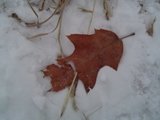
(Editor's Note: This article was originally published on January 2, 2009. Your comments are welcome, but please be aware that authors of previously published articles may not be able to promptly respond to new questions or comments.)
Winter is a time to rest from the toil of gardening. As much as we all enjoy our gardens, admittedly it is difficult work to maintain them. In the winter we can kick back and toil on our indoor projects. But don't overlook your gardens in the winter because they are not lush with greenery or loaded with blooms. Bundle up and tour your gardens in the winter. You may see them with new eyes. But first join me on a tour of my winter garden, if you will. And you won't need to bundle up for this winter garden tour unless, of course, you want to create the ambience of winter at your laptop.
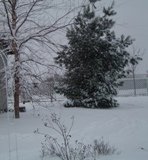 We begin the tour by strolling beneath the arbor which opens into the Magnolia Garden. Notice how the White Pine, (Pinus strobus, also called Eastern White Pine) creates a striking backdrop for the deciduous River Birch. This birch tree has curling, cinnamon colored bark and lower limbs which drape gently to the ground. It is a delicate addition which will enhance the winter landscape. To learn more about the River Birch tree, also called Red Birch, you can research it by its scientific name, Betula nigra.
We begin the tour by strolling beneath the arbor which opens into the Magnolia Garden. Notice how the White Pine, (Pinus strobus, also called Eastern White Pine) creates a striking backdrop for the deciduous River Birch. This birch tree has curling, cinnamon colored bark and lower limbs which drape gently to the ground. It is a delicate addition which will enhance the winter landscape. To learn more about the River Birch tree, also called Red Birch, you can research it by its scientific name, Betula nigra.
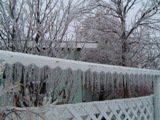 What would a winter garden tour be without the artwork of the otherwise simple fence? It is a true work of art fashioned by the master of winter creations. Draw the fresh, icy air deep into your lungs and wrap your scarf tighter as we continue the tour.
What would a winter garden tour be without the artwork of the otherwise simple fence? It is a true work of art fashioned by the master of winter creations. Draw the fresh, icy air deep into your lungs and wrap your scarf tighter as we continue the tour.
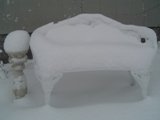
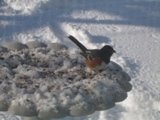 As we arrive in the Magnolia Garden you may want to have a seat on the bench. Please do, brush away the snow and sit awhile. By the way, you may freeze to the bench. But that is part of the atmosphere of the gardens in winter. The bird is a Rufous-sided Towhee.
As we arrive in the Magnolia Garden you may want to have a seat on the bench. Please do, brush away the snow and sit awhile. By the way, you may freeze to the bench. But that is part of the atmosphere of the gardens in winter. The bird is a Rufous-sided Towhee.

 Adding statuary to the garden will guarantee winter interest. The snow and ice will make the statues over into unique figures.
Adding statuary to the garden will guarantee winter interest. The snow and ice will make the statues over into unique figures.
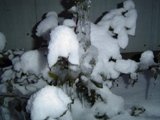
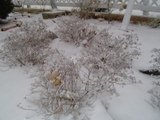 Some people believe small or dwarf variety plants are unsuitable additions for enhancing the winter landscape. And while it is true that the smaller plants may be hidden beneath the snow for a good portion of the winter in some climates, there are climates where the plants can be viewed. When designing your winter garden, do not rule out plants that lack height. Add some smaller plants to stand-down the medium to large plantings. On the days when the snowfall has not covered the shorter plants entirely they create miniature winter sculptures at the base of the taller trees and shrubs. The first photograph is a Ilex x meserveae 'Blue Girl', a holly, not yet fully grown. It is an oddity tangled in snow and ice. In the second photo are several Spiraea japonica 'Shirobana' which seem to hold hands and dance round one another in the snow. The Spiraea japonica are small shrubs, but they capture the attention of the observer.
Some people believe small or dwarf variety plants are unsuitable additions for enhancing the winter landscape. And while it is true that the smaller plants may be hidden beneath the snow for a good portion of the winter in some climates, there are climates where the plants can be viewed. When designing your winter garden, do not rule out plants that lack height. Add some smaller plants to stand-down the medium to large plantings. On the days when the snowfall has not covered the shorter plants entirely they create miniature winter sculptures at the base of the taller trees and shrubs. The first photograph is a Ilex x meserveae 'Blue Girl', a holly, not yet fully grown. It is an oddity tangled in snow and ice. In the second photo are several Spiraea japonica 'Shirobana' which seem to hold hands and dance round one another in the snow. The Spiraea japonica are small shrubs, but they capture the attention of the observer.
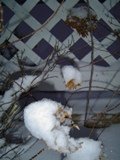 The Peegee Hydrangeas in my Sunset Garden look as though they have been dipped in snow. This area of my yard is named for the Red Sunset Maple tree which overlooks it. The 'Red Sunset' maple is a showoff in the fall with spectacular colors. Look for the Red Sunset tree at your local garden center. Research it by its scientific name, Acer rubrum. Peegee Hydrangea may be researched by its scientific name as well. It is called Hydrangea paniculata 'Grandiflora'.
The Peegee Hydrangeas in my Sunset Garden look as though they have been dipped in snow. This area of my yard is named for the Red Sunset Maple tree which overlooks it. The 'Red Sunset' maple is a showoff in the fall with spectacular colors. Look for the Red Sunset tree at your local garden center. Research it by its scientific name, Acer rubrum. Peegee Hydrangea may be researched by its scientific name as well. It is called Hydrangea paniculata 'Grandiflora'.
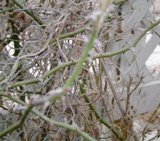 From the Sunset Garden we traipse through the snow into the Dooryard Garden. The green canes of my Seven Sisters rose greet us. They remained green right through November and into December. This added interest to the Dooryard Garden and made for quite the conversation piece. The Seven Sisters rose is an old world Species Rose dating back to 1817. In the spring it has clusters of seven or more roses in varying shades of pink.
From the Sunset Garden we traipse through the snow into the Dooryard Garden. The green canes of my Seven Sisters rose greet us. They remained green right through November and into December. This added interest to the Dooryard Garden and made for quite the conversation piece. The Seven Sisters rose is an old world Species Rose dating back to 1817. In the spring it has clusters of seven or more roses in varying shades of pink.
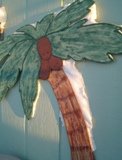 Stepping from the Dooryard Garden onto the front porch we discover a shocking bit of green. A palm tree? Yes, this is my palm tree. It lives on the porch and remains lush all year long. I designed and cut it from plywood. It adds a touch of tropical whimsy to my winter landscape.
Stepping from the Dooryard Garden onto the front porch we discover a shocking bit of green. A palm tree? Yes, this is my palm tree. It lives on the porch and remains lush all year long. I designed and cut it from plywood. It adds a touch of tropical whimsy to my winter landscape.
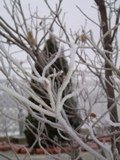 The winter garden tour has come to an end. There are many plants which will add interest to the winter landscape. Research is key. Before you add new plants to the garden, do the research. Look for plants with distinctive characteristics. These characteristics mark the plants as good choices for enhancing the winter landscape.
The winter garden tour has come to an end. There are many plants which will add interest to the winter landscape. Research is key. Before you add new plants to the garden, do the research. Look for plants with distinctive characteristics. These characteristics mark the plants as good choices for enhancing the winter landscape.
Copyright © www.100flowers.win Botanic Garden All Rights Reserved